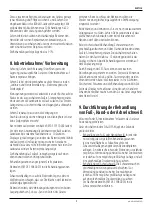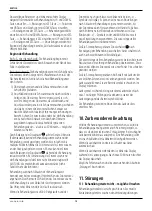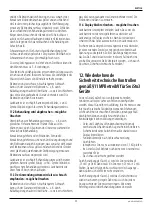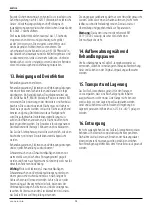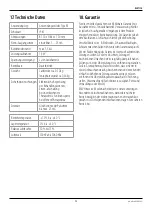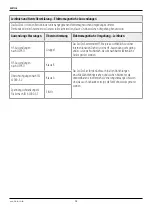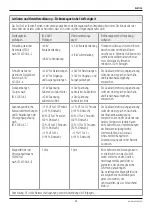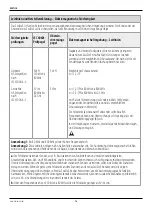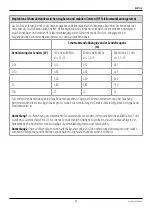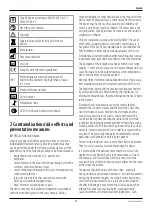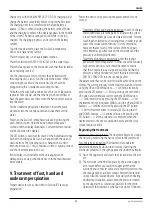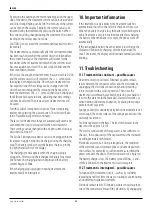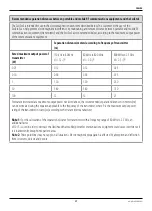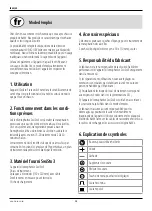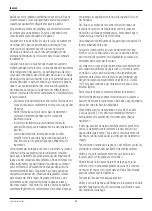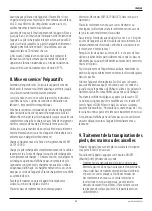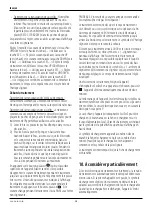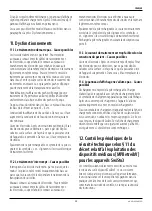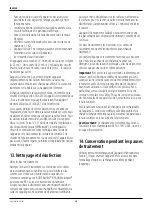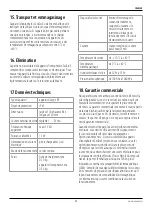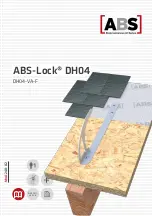
www.kawemed.com
23
the electrode connection pin and reinserting it into its socket
with a twisting motion.
The battery charge is low. The treatment current is turned off.
The battery symbol blinks, + and - symbols blink when the
treatment circuit is complete. Charge the battery as described
in Section 8.
11.3 Treatment current feels too weak – possible
causes
Electrodes are worn. After prolonged use, the condition of the
electrodes can deteriorate (due to calcium deposits on their
surface, for example) to such an extent as to inhibit the power
output of the device. The electrodes are to be replaced.
11.4 Display does not illuminate – possible causes
Battery is completely discharged. First charge the battery with
the supplied charging plug. The charging symbol will appear
on the display. Soon after the battery has begun charging, the
device switches automatically to charging mode.
If the charging plug is plugged in and still no charging symbol
appears on the display, check the voltage of the electrical
outlet that is being used with appropriate equipment. If the
electrical outlet is functioning properly, the SwiSto3 and the
charging plug must be inspected at a location authorised by
KaWe – see as well the Section “Safety Inspections”.
12. Recurring safety inspections
pursuant to §11 of the Medical
Products Ordinance for SwiSto3
devices
The SwiSto3 device must be inspected at least every two years
by individuals able to perform such safety inspections properly
due to their training, knowledge and practical experience, and
do not require any special instructions with regard to these
inspection activities.
- Visually inspect the device and accessories for mechanical
damage that would adversely affect their functionality.
- Check safety-related labels and the display to insure that
they are legible.
- Perform function check as instructed in the user’s manual.
- Test the iontophoresis current with a load resistance of 1.5
KΩ.
- The SwiSto3 device contains no parts that require
maintenance by the user.
- The housing may not be opened!
When the (+) button is pressed, the current intensity is set to
25 mA. For this, a current of 25 mA ± 2 mA is necessary. Then
a short-circuit test is performed on the output, whereby the
values must not change.
When the (-) button is pressed, the current intensity output
of the device gradually diminishes. Here, the current value
must decrease with each decreasing display increment. The
treatment current is tested with a reference instrument.
During technical safety inspections, an electrical safety
inspection pursuant to IEC 62353 (Medical Electrical Devices
- Repeat Tests and Tests After Repair of Medical Electrical
Equipment) or IEC 60601-1 is to be performed.
The equivalent leakage currents may be up to 1.5 times that of
the first measured value and at the same time may not exceed
the limiting value. The first measured values are given in the
enclosed test reports. The safety inspection must be entered
into the technical manual in accordance with § 6 MPG of the
regulations pertaining to the sale of iontophoresis devices and
the inspection results must be documented. If the device is
found to not be functional and/or safe to operate, it is to be
repaired or the user of the device is to be notified of the risks
of using the device.
13. Cleaning and disinfection
Empty the water trays.
Wipe the water trays, electrodes and connector cables with
a dry cloth and then disinfect them as follows: use any
commonly-used disinfecting agent such as Bode Bacillol®,
BRAUN Meliseptol® or orochemie B30. The instructions
given by the manufacturer of the disinfecting agent are to
be followed. The surface that is to be disinfected must be
wiped with the disinfectant using light pressure, such that the
surface is wet enough and enough of the active ingredient of
the disinfecting agent is deposited. The applied disinfectant
solution is to be allowed to dry on the surfaces and they may
not be wiped dry. The reaction/wait time for the above-named
disinfecting agents is 5 minutes and must be observed.
The SwiSto3 iontophoresis device is to be wiped down weekly
with a disinfecting agent.
Water trays, electrodes and connector cables are to be
disinfected before each use!
Sponge pockets can be rinsed with warm water, but not with
any kind of cleaning agent and for hygienic reasons, are each
to be used only by one and the same patient.
ENGLISH
Summary of Contents for SwiSto3
Page 3: ...Deutsch English Fran ais Italiano Espa ol Portugu s 6 17 18 29 30 41 42 53 54 65 66 77 78 89...
Page 4: ......
Page 79: ...www kawemed com 79 BF DIN IEC 601 1 VDE 0750 1 LOT IP41 1 0 REF SN 7 2 KaWe 1...
Page 80: ...www kawemed com 80 0 2 KaWe 4 8 800...
Page 86: ...www kawemed com 86 SwiSto3 CISPR 11 1 SwiSto3 CISPR 11 B SwiSto3 IEC 61000 3 2 A IEC 61000 3 3...
Page 90: ......
Page 91: ......

